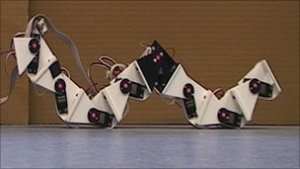For researchers, inspiration for building robots has come in from the walking patterns of spiders, lobsters and crabs. A study of their movements has revealed that their legs have rhythmic nerve impulses, which control their gait.
These patterns have been included in modular control elements, which could be transferred into robots so that they could mimic the movements of these creatures. Researchers from Europe have incorporated the control systems known as CPGs inside a robot worm.
 The worm robot mimics the movements of real world worms
The worm robot mimics the movements of real world worms
According to Fernando Herrero, a Spanish researcher who uses the CPGs, these rhythmic impulses were the best known of all the neural circuits and they allow the body to perform repetitive tasks such as walking and chewing. Initially, the activity would need some amount of input, but the repetitive motions finally run on auto pilot. These CPGs are easily understood as when compared to the mammals the invertebrate neural systems are relatively simple, and their interconnecting nerves could be easily mapped.
Normally, robot makers use a series of rules for movements of the legs. However, according to Herrero, CPGs would generate the rhythms without any rules, thereby being in a position to deal with unexpected situations. They are discrete circuits, which could be connected like building blocks to develop complex behaviors.
It was possible to focus on each part of each leg such as ankle, knee, hip etc and design, controller mini CPGs for them and connect them to get a leg-CPG mechanism, which would act in a synchronized manner. Herrero along with his fellow researchers, Francisco Rodriguez and Pablo Varona had utilized CPGs as a control system in a worm robot with eight sections. This robot was based on a machine developed by Dr Juan Gomez from the Carlos III University in Madrid. The research was published in the Journal Bioinspiration and Biometrics.